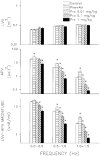Assessment of cardiac sympathetic regulation by respiratory-related arterial pressure variability in the rat
- PMID: 10066913
- PMCID: PMC2269192
- DOI: 10.1111/j.1469-7793.1999.887ab.x
Assessment of cardiac sympathetic regulation by respiratory-related arterial pressure variability in the rat
Abstract
1. Mechanical ventilation evokes a corresponding arterial pressure variability (APV) which is decreased by beta-adrenoceptor antagonism. Therefore, in this study we set out to determine whether the respiratory-related APV can be used to assess cardiac sympathetic tone. 2. Computer-generated broad-band mechanical ventilation (0-3 Hz) was applied to Sprague-Dawley rats that had been anaesthetized with ketamine and paralysed with pancuronium. APV and its relationship to lung volume variability (LVV-APV) was systematically quantified with auto- or cross-spectral frequency domain analysis. 3. APV and LVV-APV transfer magnitudes between 0.5 and 1.5 Hz showed dose-dependent suppression by propranolol from 0.01 to 1 mg kg-1, while the static value of arterial pressure remained unchanged. Stroke volume variability, assessed by the use of a pulse contour method, exhibited a similar pattern of suppression by propranolol. In contrast, heart rate variability was not lowered with propranolol. 4. The effect of propranolol on respiratory-related APV persisted even in the presence of combined alpha-adrenoceptor and muscarinic receptor blockade by phentolamine and atropine. 5. The frequency range of 0.5-1.0 Hz was optimal for LVV-APV transfer magnitude to correlate with cardiac sympathetic tone. 6. We conclude that respiratory-related APV may provide a valid assessment of cardiac sympathetic regulation which is independent of parasympathetic and vascular sympathetic influences in ketamine-anaesthetized and positive pressure-ventilated rats.
Figures





Similar articles
-
Impact of pulse pressure on the respiratory-related arterial pressure variability and its autonomic control in the rat.Pflugers Arch. 2000 Apr;439(6):772-80. doi: 10.1007/s004249900230. Pflugers Arch. 2000. PMID: 10784352
-
Transfer function analysis of ventilatory influence on systemic arterial pressure in the rat.Am J Physiol. 1996 Nov;271(5 Pt 2):H2108-15. doi: 10.1152/ajpheart.1996.271.5.H2108. Am J Physiol. 1996. PMID: 8945931
-
Dynamic effects of respiration on aortic blood flow and its autonomic control in rats.Clin Exp Pharmacol Physiol. 2008 Nov;35(11):1294-300. doi: 10.1111/j.1440-1681.2008.04998.x. Epub 2008 Jul 9. Clin Exp Pharmacol Physiol. 2008. PMID: 18637018
-
Sympathetic modulation of blood pressure variability.J Hypertens. 2001 Oct;19(10):1707-12. doi: 10.1097/00004872-200110000-00002. J Hypertens. 2001. PMID: 11593088 Review.
-
Low and high frequency components of blood pressure variability.Ann N Y Acad Sci. 1996 Aug 15;783:10-23. doi: 10.1111/j.1749-6632.1996.tb26704.x. Ann N Y Acad Sci. 1996. PMID: 8853630 Review. No abstract available.
Cited by
-
Effects of age and sex on vasomotor activity and baroreflex sensitivity during the sleep-wake cycle.Sci Rep. 2022 Dec 27;12(1):22424. doi: 10.1038/s41598-022-26440-3. Sci Rep. 2022. PMID: 36575245 Free PMC article.
-
Model-based assessment of cardiovascular autonomic control in children with obstructive sleep apnea.Sleep. 2009 Jul;32(7):927-38. doi: 10.1093/sleep/32.7.927. Sleep. 2009. PMID: 19639756 Free PMC article.
-
Frequency components of systolic blood pressure variability reflect vasomotor and cardiac sympathetic functions in conscious rats.J Physiol Sci. 2011 Sep;61(5):373-83. doi: 10.1007/s12576-011-0158-7. Epub 2011 Jun 29. J Physiol Sci. 2011. PMID: 21713646 Free PMC article.
-
Impact of lung inflation cycle frequency on rat muscle and skin sympathetic activity recorded using suction electrodes.Auton Neurosci. 2009 Oct 5;150(1-2):70-5. doi: 10.1016/j.autneu.2009.05.240. Epub 2009 May 19. Auton Neurosci. 2009. PMID: 19457723 Free PMC article.
-
Abnormal cardiac autonomic regulation in mice lacking ASIC3.Biomed Res Int. 2014;2014:709159. doi: 10.1155/2014/709159. Epub 2014 Apr 3. Biomed Res Int. 2014. PMID: 24804235 Free PMC article.
References
-
- Ashton JH, Cassidy SS. Reflex depression of cardiovascular function during lung inflation. Journal of Applied Physiology. 1985;58:137–145. - PubMed
-
- Berger RD, Saul JP, Cohen RJ. Transfer function analysis of autonomic regulation. I. Canine atrial rate response. American Journal of Physiology. 1989;256:H142–152. - PubMed
-
- Cerutti C, Gustin MP, Paultre CZ, Lo M, Julien C, Vincent M, Sassard J. Autonomic nervous system and cardiovascular variability in rats: a spectral analysis approach. American Journal of Physiology. 1991;261:H1292–1299. - PubMed
-
- Connelly CA, Wurster RD. Sympathetic rhythms during hyperventilation-induced apnea. American Journal of Physiology. 1985;249:R424–431. - PubMed
Publication types
MeSH terms
Substances
LinkOut - more resources
Full Text Sources

